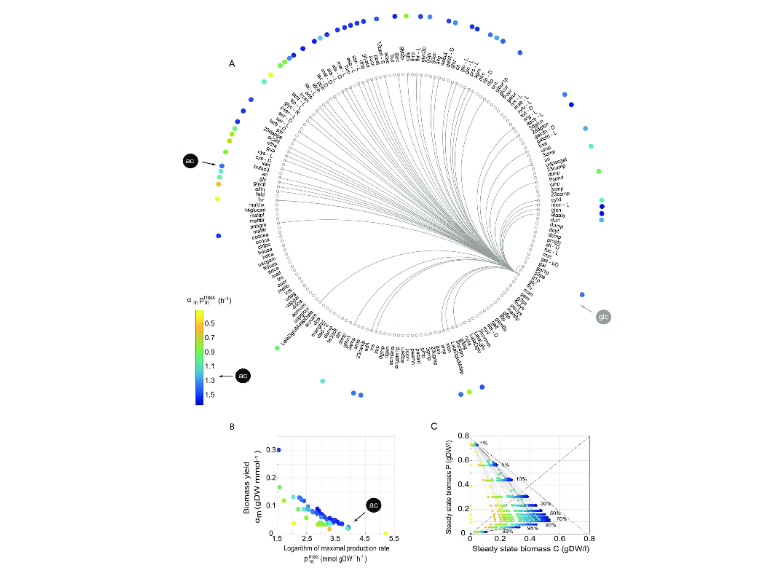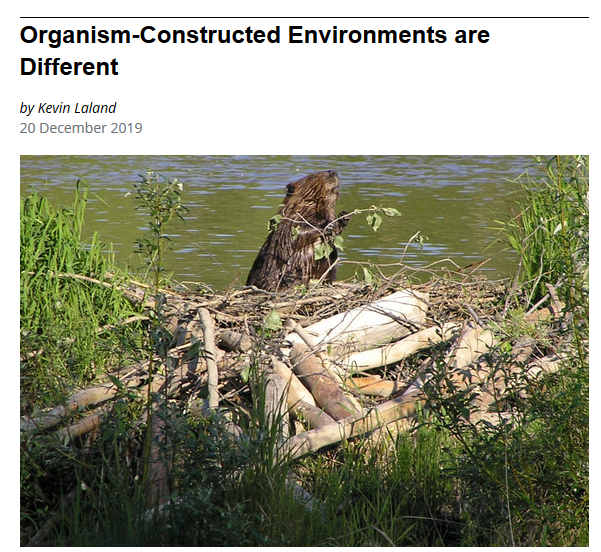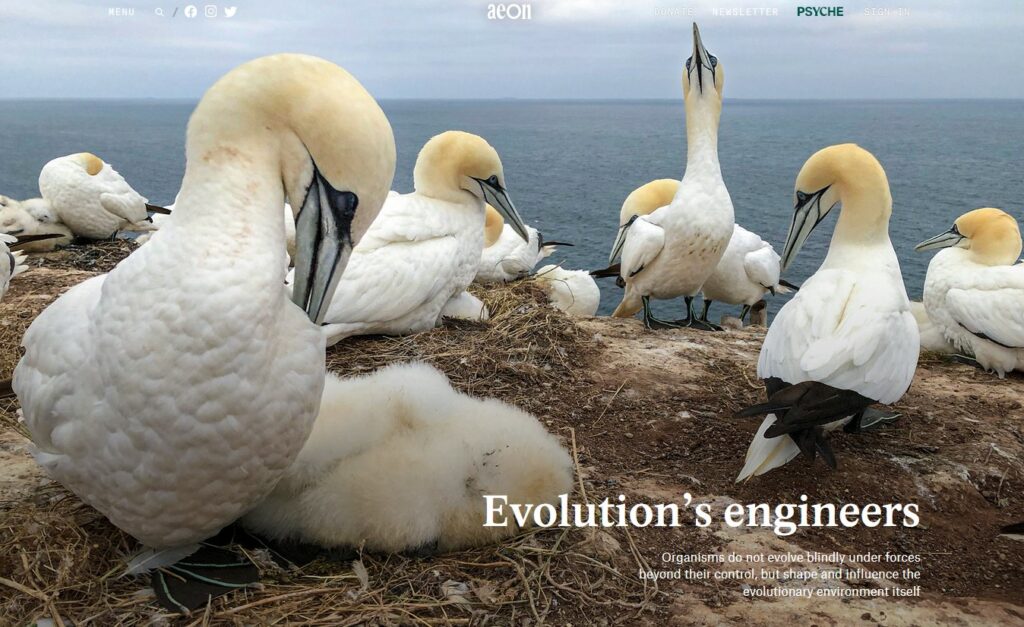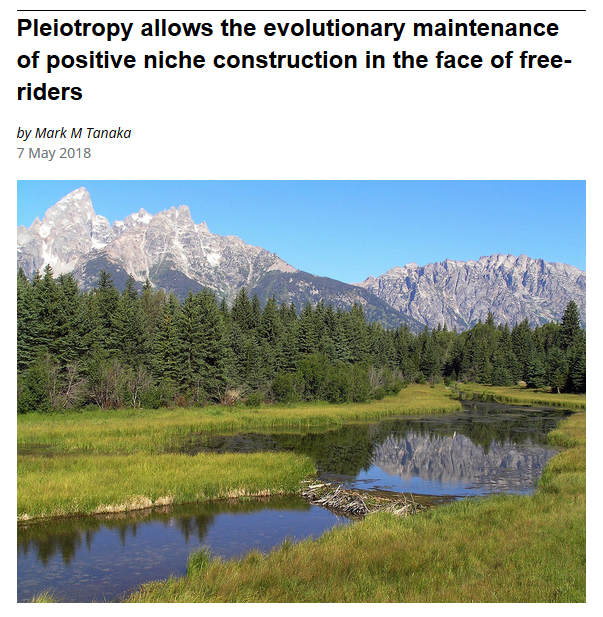What’s new about niche construction theory?
Niche construction theory contrasts with conventional conceptualizations of evolution in recognizing niche construction as an evolutionary cause or process. The niche-construction perspective seeks to explain the adaptive complementarity of organism and environment in terms of a dynamic, reciprocal interaction between the processes of natural selection and niche construction.
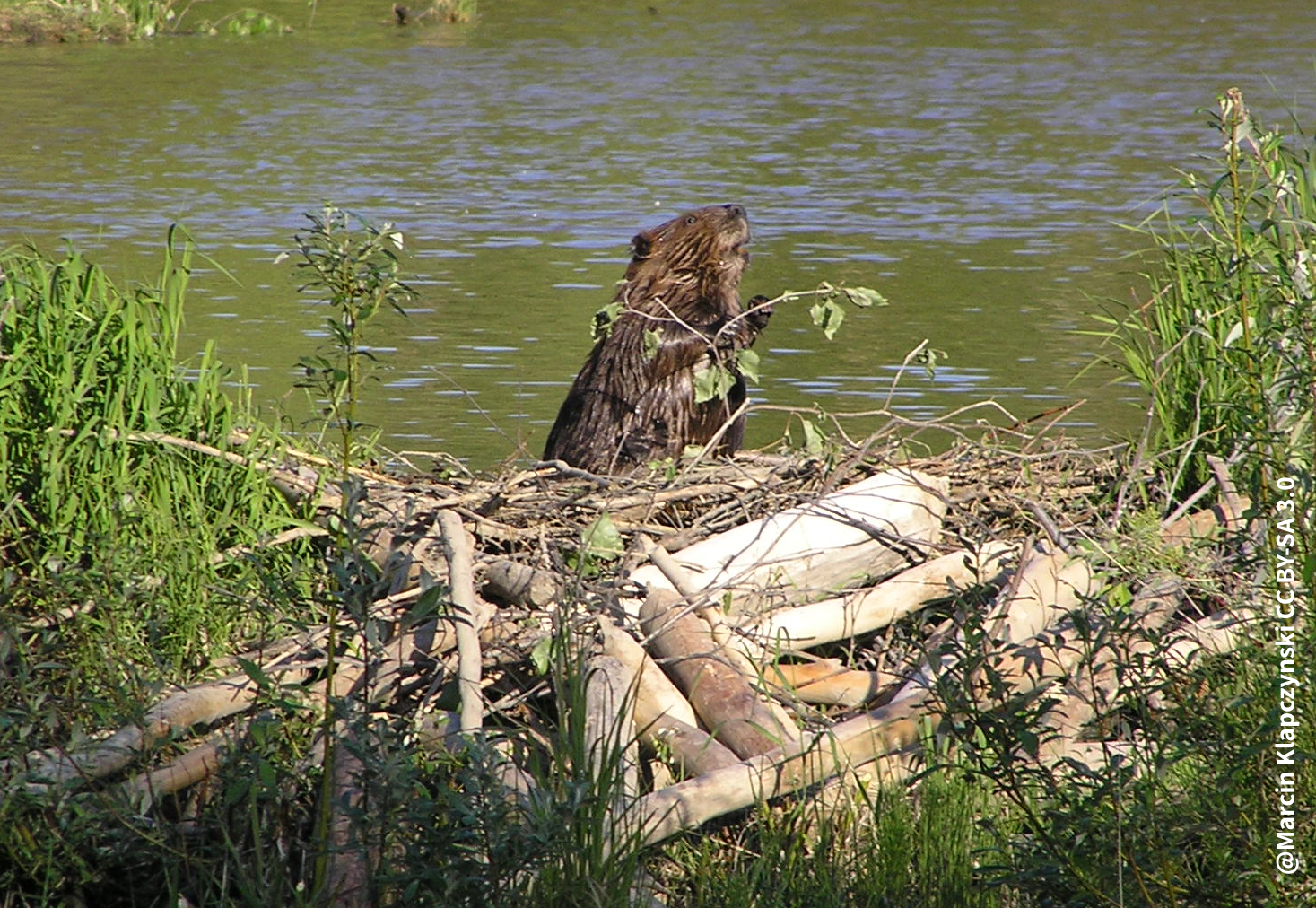
The distinctive aspects of the niche-construction perspective are illustrated by the familiar example of the beaver. Generally, the evolutionary consequences of beaver dam building are modeled in terms of fitness ‘payoffs’ to the underlying genes; selection favors dam-building alleles over their alternatives. According to Richard Dawkins (1982), who exemplifies the traditional standpoint, dams can be viewed as ‘extended phenotypes’Biological adaptations expressed outside of the body of the organism. – adaptations expressed outside of the constructor’s body, but that evolve in a manner no different from other adaptations.
From the niche-construction perspective this stance is unsatisfactory, both because it misses part of the causal story and because it discourages consideration of additional forms of selective feedback. When a beaver builds a dam, creating a lake and influencing river flow, it not only affects the propagation of dam-building genes but dramatically changes its local environment, affecting nutrient cycling, decomposition dynamics, the structure of the riparian zone, and plant and community composition and diversity. It follows that beaver dam building must also transform selection acting on a host of other beaver traits. The active agencyThe capacity of living organisms to act on, and in, their world, and to modify their experience of it, including in ways that are neither predetermined, nor random. of beavers in constructing these modified selection pressures and thereby acting as co-directors of their own evolution (not to mention that of other species) currently goes unrecognized.
Often the modifications produced by niche-constructing organisms persist for longer than the individual constructors, continuing to modulate the impact of environment on subsequent generations, a legacy described as an ‘ecological inheritance’The inheritance, via an external environment, of one or more natural selection pressures previously modified by niche-constructing organisms.. Descendants of the dam builder will experience modified selection so long as the dam, lake, and transformed environment remain. Given that dams are frequently maintained by families of beavers for decades, that could be considerably longer than the lifetime of an individual beaver. In addition to genes, offspring inherit a modified selective environment.
While it is possible to study this feedback using established evolutionary theory, for instance through models of habitat selection, co-evolution or maternal effects, nonetheless the magnitude and significance of niche construction remains underappreciated, in part because standard evolutionary theory does not encourage attention to such phenomena.
Conversely by treating niche construction as an evolutionary process – one that is influenced by, but not solely reducible to, earlier natural selection – niche construction theory generates novel hypotheses and new methods that stimulate research. The perspective is rapidly growing, precisely because researchers from multiple disciplines find it useful.
Contents
Evolutionary significance of niche construction
Several factors render niche construction of evolutionary significance:
(1) Niche construction biases natural selection
Organisms do not modify environments at random. Rather, they create environmental states, such as nests, burrows or benign conditions, that are adaptive for the constructor or its descendants. They can also destroy environments, or produce conditions that impact negatively on fitness. Studies show that environmental features constructed by organisms have different properties, and generate different patterns of selection, to aspects of environments that change independently of the organism (Clark et al. 2020). For instance, selection in response to environmental components regulated by organisms is consistently weaker and less variable than selection arising from autonomous aspects of environments. Organisms modify environments in distinctive, nonrandom ways, thereby imposing a systematic bias on natural selection.
The orderly nature of niche construction follows largely because it has evolved through earlier natural selection. However, this does not mean it can be disregarded. Organisms are influenced, but not determined, by their genes, and their activities are shaped by developmental information-gaining processes as well as natural selection. Organisms are not merely objects through which the causal explanatory power of natural selection flows; rather they are active agents that transduce and filter genetic inputs that derive from prior selection, as well as environmental inputs.
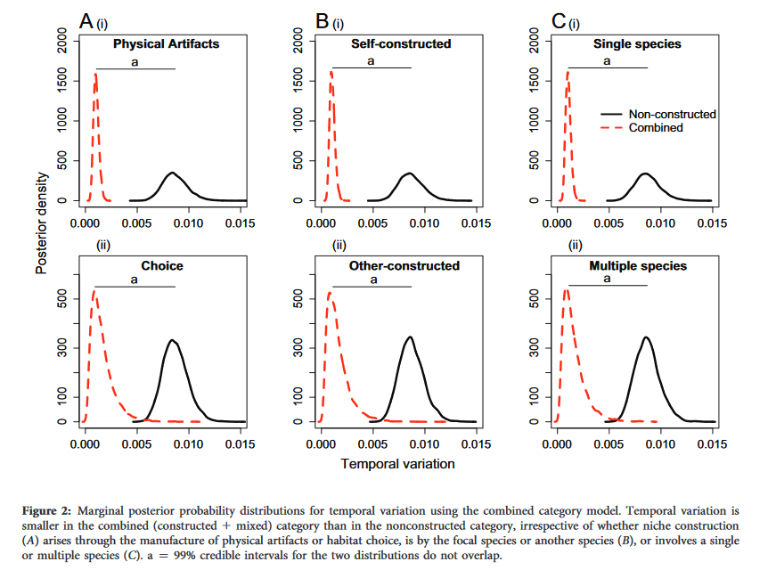
(2) Niche construction generates ecological inheritance
Ecological inheritance refers to the inherited resources and conditions, and associated modified selection pressures, that ancestral organisms pass on to their descendants as a direct or indirect result of their niche construction. For instance, if a beaver builds a dam transforming its local ecology, the modified selection will remain in the beaver’s environment just so long as the dam, lake, and modified environment persist, which can be decades. Likewise, the changes that earthworms produce in the soil can last many generations and can increase the fitness of the descendants (see Blog: Evolution’s Engineers).
It is well-recognized that environments can exhibit constancy across generations, but this is not generally viewed as an inheritance. Yet these ecological legacies have been shown to affect evolutionary dynamics strongly, and to contribute to parent-offspring similarity (Odling-Smee et al. 2003; Badyaev & Uller 2009; Odling-Smee et al. 2013). The stable inheritance of traits results in part from parents constructing developmental environments for their offspring (Badyaev & Uller 2009).
In recent years many evolutionary biologists have sought to expand the concept of inheritance within evolutionary biology, and ecological inheritance is now commonly incorporated into these schemes (Danchin et al. 2011; Bonduriansky 2012).
(3) Learning can be evolutionarily significant
There is considerable interest among evolutionary biologists in the role that imprinting, song learning, habitat imprinting, cultural transmission and various other forms of learning, play in speciation, the evolution of adaptive specializations, adaptive radiations, the colonization of new habitats, brood parasitism and sexual selection in vertebrates (ten Cate 2000; Laland et al. 2019; Whitehead et al. 2019).
From the niche-construction perspective, acquired characters, such as learned behaviour, can be evolutionarily important. Social learning in particular, is likely to exert a widespread influence on animal evolution. For instance, different clans of killer whales feed on very different prey species, with individuals learning their dietary preferences from older group members. As a consequence, clans have evolved specific jaws and digestive systems adapted to cope with their learned diets. Killer whales may currently be evolving into multiple separate species because of their cultural differences (Foote et al. 2016).
The learning of one species can influence the evolution of another. Reed warblers, for instance, learn to recognize cuckoos as brood parasites by attending to the alarm calls of other birds, a knock-on consequence of which is that natural selection favors cuckoos with unusual plumage patterns (Thorogood & Davies 2012). This gene-culture coevolution is of particular relevance to human evolution (Laland et al. 2010).

(4) Byproducts are evolutionarily significant
The niche-construction perspective highlights the important roles that byproducts can play in ecosystems. Such roles are not intuitive. For instance, it is far more apparent that the beaver’s dam may drive coevolutionary episodes than beaver’s dung may, yet the latter is a very real possibility. Numerous examples have been documented of seemingly inconsequential and inadvertent acts by organisms whose aggregate activity generates important consequences. For example, consider Euchondrus snails whose consumption of endolithic lichens inadvertently generates tonnes of soil, thereby playing a vital role in desert ecosystems (Jones & Shachak 1990).
Typically, biologists assume that if a niche-constructing activity generates evolutionary feedback to the constructor, then it must be an adaptation. In fact, theory shows this need not be the case. Byproducts can induce selection on other traits in the same population and hitchhike to fixation on the back of this selection (Silver & Di Paolo 2006). Here, spatial structure (local dispersal and mating) gives rise to statistical associations between niche-constructing traits and genotypes favored in the constructed environments. There is selection of the niche-constructing trait, but not selection for it, and only the latter meets the definition of an adaptation (Williams 1966; Sober 1984). Nonetheless, in such hitchhiking cases, there remains evolutionarily consequential feedback to a niche-constructing population stemming from its constructing activities.
(5) Niche construction creates a second route to adaptation
Evolutionary theory has historically focused on how organisms are shaped by natural selection to become suited to their environments. The niche-construction perspective emphasizes that through niche construction, environments can be changed by organisms to suit themselves. For instance, Turner (2000) notes that, despite living on land for millions of years, earthworms have retained the physiology characteristic of the freshwater worms from which they evolved. The earthworms process the soil in ways that allow them to draw water into their bodies more effectively, constructing a simulated aquatic environment on land. The adaptive complementarity of earthworms and soils results to a large extent from the worms changing the soil through niche construction, rather than the worms evolving a typical terrestrial physiology through natural selection.
These findings have led to the claim that niche construction is more than just a product of evolution, or source of environmental change, but should be recognized as a causal evolutionary process through its guiding influence on selection.
(6) Niche construction opens up new ecological niches
Through their niche construction, organisms can open up new ecological niches, both for themselves and for other species. Experiments have shown that niche construction evolves rapidly, under a broad range of conditions (Callahan et al. 2014), often leading to the creation of new niches. For instance, San Roman & Wagner’s (2018) experimental evolution investigation in bacteria showed that huge biodiversity could emerge in a completely homogeneous environment through niche construction. They found that bacteria created new ecological niches when they excrete nutrient-rich waste products that could sustain other bacteria, and identified thousands of such niches that had been created in this manner. Rather than lineages simply diversifying to “fill” available niches, niches themselves may be diversifying (Erwin 2005). Recent theoretical work shows that the construction of new niches by organisms has long-term, macro-evolutionary effects, for instance, increasing the branching patterns of phylogenetic trees (Xue et al. 2020).
Key readings
Badyaev AV, Uller T. 2009. Parental effects in ecology and evolution: mechanisms, processes and implications. Philosophical Transactions of the Royal Society B. 364: 1169-1177 Provides evidence that organisms construct developmental environments for their offspring.
Callahan BJ, Fukami T, Fisher DS. 2014. Rapid evolution of adaptive niche construction in experimental microbial populations. Evolution 68(11): 3307-3316 Demonstrates experimentally that niche construction evolves rapidly, under a broad range of conditions, in microbial populations.
Clark AD et al. 2020. Niche construction affects the strength and variability of natural selection. The American Naturalist 195(1): 16-30. This meta-analysis of selection gradients provides clear evidence that the natural selection that arises from constructed environments differs from that from autonomous environments.
Erwin DH (2008) Macroevolution of ecosystem engineering, niche construction and diversity. Trends Ecol Evol 23: 304–310. This review illustrates how niche construction produces effects that persist over geological time, modulating macroevolutionary patterns and diversity.
Odling-Smee FJ, Laland KN, Feldman MW 2003. Niche Construction: The Neglected Process in Evolution. Princeton: Princeton University Press An authoritative, rigorous and extensive introduction to niche construction theory.
San Roman M & Wagner A 2018. An enormous potential for niche construction through bacterial cross-feeding in a homogeneous environment. Shows experimentally that bacteria create new ecological niches when they excrete nutrient-rich waste products that sustain other bacteria
Sultan SE 2015. Organism & environment: Ecological development, niche construction, and adaptation. Oxford: Oxford University Press The most up-to-date authoritative and comprehensive treatment of niche construction, packed with empirical examples, particularly in plants and animals.
Whitehead H, Laland KN, Rendell L, Thorogood R, Whiten A. 2019. The reach of gene-culture coevolution in animals. Nature Communications. 10: 2405 Reviews evidence for animal learning affecting biological evolution.
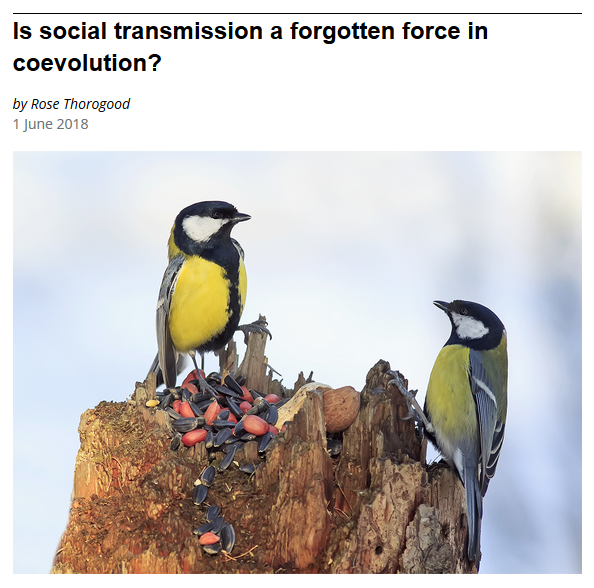 Blog article: “Is social transmission a forgotten force in coevolution?” by Rose Thorogood
Blog article: “Is social transmission a forgotten force in coevolution?” by Rose Thorogood
Evolutionary models of niche construction
Mathematical evolutionary theory suggests that niche construction is of considerable ecological and evolutionary importance. It has been found to affect evolutionary equilibria, rates, and dynamics, drive coevolution, facilitate cooperation, and generate range expansion.
There is now an extensive body of formal theory that explores the evolution of niche construction and its ramifications for evolutionary biology and ecology. Mathematical analyses suggest that niche construction is of considerable ecological and evolutionary importance.
For instance, niche construction can:
(i) fix genes or phenotypes that would, under standard evolutionary theory, be deleterious, create or eliminate equilibria, and affect evolutionary rates (Laland et al. 1999; Silver & Di Paolo 2006; Creanza & Feldman 2014, Tanaka et al. 2020),
(ii) cause evolutionary time lags, generate momentum, inertia, autocatalytic effects, catastrophic responses to selection, and cyclical dynamics (Laland et al. 1999; Creanza & Feldman 2014, Tanaka et al. 2020);
(iii) drive niche-constructing traits to fixation by creating statistical associations with recipient traits (Silver & Di-Paolo 2006);
(iv) be favored, even when currently costly, because of the benefits that will accrue to distant descendants (Lehmann 2007, 2008).
(v) facilitate the evolution of cooperation (Lehmann 2008; van Dyken & Wade, 2012) and evolve to produce public goods (Chisholm et al. 2018).
(vi) regulate environmental states, allowing persistence in otherwise inhospitable conditions, facilitating range expansion and affecting carrying capacities (Kylafis & Loreau 2008; Krakauer, Page & Erwin 2009), and promoting evolutionary rescue (Longcamp & Draghi 2023).
(vii) drive coevolutionary events, exacerbate and ameliorate competition, affect the likelihood of coexistence and produce macroevolutionary trends (e.g. Krakauer, Page & Erwin 2009).
(viii) strongly affect heritability, and challenges how it is commonly defined and measured (Uller & Helanterä 2020; see video on the right to learn more).
(ix) affect drift and gene flow, for instance, by creating suitable habitat that increases carrying capacities (Gurney & Lawton 1996), or through nonrandom dispersal which biases gene flow (Whitehead et al. 2019).
Key readings
Chisholm RH 2018. The role of pleiotropy in the evolutionary maintenance of positive niche construction. The American Naturalist. 192(1): 35-48 Shows that positive niche construction can both evolve and be maintained when it has other beneficial effects via pleiotropy.
Creanza N, Feldman MW. 2014. Complexity in models of cultural niche construction with selection and homophily. Proceedings of the National Academy of Sciences USA. 111(3): 10830-7 Presents a model that includes selection and homophily as independent traits that influence the fitness and mate choice determined by another trait.
Kylafis G, Loreau M. 2008 Ecological and evolutionary consequences of niche construction for its agent. Ecology Letters. 11: 1072-1081 This model shows that this niche construction allows the persistence of plants under infertile soil conditions that would otherwise lead to their extinction.
Laland KN, Odling-Smee FJ, Feldman MW. 1999. Evolutionary consequences of niche construction and their implications for ecology. Proceedings of National Academy of Sciences USA. 96 :10242–10247 Models niche construction using two-locus theory, incorporating additional processes of resource renewal and depletion.
Lehmann L. 2008. The adaptive dynamics of niche constructing traits in spatially subdivided populations: evolving posthumous extended phenotypes. Evolution. 62: 549–566 Taking an inclusive fitness approach, this model shows how the phenotypic effects of genes extend beyond the life span of the actor by modifying the fitness of descendants.
Silver M, Di Paolo EA. 2006. Spatial effects favour the evolution of niche construction. Theoretical population Biology. 70: 387-400 A spatially explicit treatment of niche construction illustrates how niche-constructing traits can drive themselves to fixation in the absence of direct selection.
Van Dyken JD, Wade MJ. 2012. Origins of altruism diversity II: runaway coevolution of altruistic strategies via reciprocal niche construction. Evolution. 66: 2498 –2513 Demonstrates how niche construction can favour altruism.
Niche construction theory and the EES
Researchers studying niche construction commonly embrace an alternative perspective in which niche construction is regarded as a fundamental evolutionary process in its own right. Evolution entails networks of causation and feedback in which previously selected organisms drive environmental changes, and organism-modified environments subsequently select for changes in organisms.
The perspective is intellectually aligned with several other movements within evolutionary biology, including ‘developmental systems theory’ (Oyama et al. 2001), the active role of behavior (Bateson 1988), and of developmental plasticity (West-Eberhard 2003), in evolution, and calls for an extended evolutionary synthesisA new evolutionary framework emphasizing that knowledge of how organisms develop, grow, and interact with environments helps to account for adaptation and the diversity of life. (Pigliucci & Muller 2010; Laland et al. 2015).
The extended evolutionary synthesis, or EES, is a new way to think about and understand evolutionary phenomena that differs from the conception that has dominated evolutionary thinking since the 1930s (i.e. the modern synthesis). It is a developing line of contemporary evolutionary thought that exists within the field of evolutionary biology.

According to the EES, explaining the origin of adaptations requires understanding how developmental processes generate heritable phenotypic variants from genetic, epigenetic and environmental inputs. Developmental biasThe nonrandom generation of phenotypes by developmental systems, with variants sometimes being channeled by the processes of development towards functional goals. and phenotypic plasticityEnvironmental induction leads to developmental reorganization and production of a novel phenotypic variant. play central roles in the EES as generators of novel, yet potentially functional and coordinated, phenotypic variation. This conception of bias is different from the traditional characterization of developmental constraints: rather than accounting for the absence of evolution or adaptation, developmental bias is also a source of adaptive variation.
Developmental bias and niche construction are, in turn, recognized as evolutionary processes that can initiate and impose direction on selection. Extra-genetic inheritanceParental transference of developmental resources (mediated through genetic, epigenetic, physiological, behavioural and ecological inheritance mechanisms) that enable reconstruction of life cycles. mechanisms (which include ecological inheritance) interact with genetics and environmental inputs to construct the developing organism, thereby contributing to the similarity between ‘transmitting’ and affected individuals.
Like niche construction theory, the EES emphasizes how organisms shape and are shaped by selective and developmental environments (reciprocal causationProcess A is a cause of process B and, subsequently, process B is a cause of process A. Reciprocal causation captures the idea that developing organisms are not solely products, but are also causes, of evolution.), and how the development of organisms is not programmed but open-ended and constructive (constructive developmentThe developing organism shapes its own developmental trajectory by responding to environmental inputs and altering internal and external states.). Developmental processes, operating through developmental bias and niche construction, are viewed as sharing with natural selection some responsibility for the direction and rate of evolution and contribute to organism–environment complementarity.
The resulting network of processes provides a considerably more complex account of evolutionary mechanisms than traditionally recognized. The EES entails not only new research directions but also new ways to think about, and interpret, new and familiar problems in evolutionary biology.
Key readings
Laland KN, Uller T, Feldman MW, et al. 2014 Does evolutionary theory need a rethink? Nature 514:161–164 Provides a very brief introduction to the motivation for an extended evolutionary synthesis.
Laland KN, Uller T, Feldman MW, et al. 2015 The extended evolutionary synthesis: its structure, assumptions and predictions. Phil Trans R Soc B. A detailed rationale for an extended evolutionary synthesis, outlining key assumptions, themes, novel predictions and how the EES differs from the MS.
Check out the Extended Evolutionary Synthesis resource website:
Why is niche construction contentious?
The fact that niche construction occurs is not at all contentious. Its study goes back to Darwin’s classic books on earthworms and corals, although the evolutionary consequences of niche construction have not always been fully appreciated. However, the study of niche construction has become contentious because theoretical and empirical findings from niche construction theory appear to challenge some orthodox accounts of evolution.
Researchers differ over to what extent niche construction requires changes in understanding of the evolutionary process, with many advocates of the niche-construction perspective aligning themselves with others seeking an extended evolutionary synthesis (Pigliucci & Muller 2010; Laland et al. 2014, 2015), a stance that other prominent evolutionary biologists reject (Wray et al. 2014).
Why is niche construction an evolutionary process?
The theoretical argument that lies at the heart of the claim that niche construction is an evolutionary process derives from the expectation that niche construction must be purposive and goal-directed, which follows from basics of thermodynamics. The great physicist, Erwin Schrödinger (1944) first pointed out that living organisms are far-from-equilibrium systems relative to their physical or abiotic surroundings. To preserve their out-of-equilibrium status, while creating order (structure, organization) in their bodies and their immediate surrounds, organisms must do work on their environment. Living organisms can only survive by constantly exchanging energy and matter with their …environments. Schrodinger explains why this work cannot be random; it must be directional. Random niche-constructing acts would not generate order in their bodies and immediate surrounds, and hence could not provide organisms with a basis for sustained life. It follows that organisms must change environments in systematic ways (Odling-Smee et al. 2003).
Over-and-above these thermodynamic considerations, niche construction generates environmental states that are coherent and integrated with the organism’s phenotype, and that are adaptive for the constructor or its descendants, largely because the organism’s capability to do so has evolved through earlier natural selection. Organisms in the same species possess broadly similar evolved capabilities for niche construction, so they are expected to modify environmental states in broadly similar ways, while the niche construction of offspring is expected to resemble that by their parents. For these reasons, niche construction theory expects niche construction to scale up across individuals in populations and over time to generate stable modification of environmental components, and as a result to generate consistent and sustained forms of natural selection. In this manner, niche construction imposes biases on selection.
Doesn't earlier selection explain the bias in evolution produced by niche construction?
This is probably the default assumption within evolutionary biology. There are two reasons why it is problematic. First, the niche construction of living organisms is only partly explained by earlier selection. Niche constructing capabilities can also arise in development.
For illustration, the fact that humans possess an evolved capacity to learn does not provide a complete and satisfactory explanation for why some humans populations happen to take up dairy farming, and hence why those particular populations evolved adult lactose tolerance through self-imposed selection on LCT alleles.
The second reason is the causal intertwining of evolutionary processes. Niche construction can only be reduced to past natural selection in a model of evolution in which the causes of Lewontin’s (1970) three conditions of ‘phenotypic variation’, ‘differential fitness’ and ‘inheritance’ are treated as quasi-independent: conversely, where these processes are causally intertwined, this interpretation does not follow (Uller & Helanterä 2017; Laland et al. 2019).
What is not niche construction?
Niche construction is defined as ‘organism-driven environmental modification’. It thus includes any and all changes that an organism’s activities have upon the world. Niche construction, so characterized, is a universal feature of all living creatures. Even after death niche-constructing effects may persist: for instance, as a bodies decompose, they change the chemical composition of the earth around them, and sometimes leave hard parts, such as shells (Erwin 2008).
The generality of this formulation raises the question, ‘What is not niche construction?’ If almost everything an organism does is niche construction, is it still a useful concept? Yes – many biological concepts (growth, development, natural selection) apply universally, but that does not mean they are not useful. The correct question here is ‘When is it useful to emphasize that organisms engage in niche construction, and when is it not?
Some aspects of niche construction, for instance, the local fluctuations in ambient temperature caused by the movement of homothermic organisms, are frequently so trivial that they are best ignored. Incorporating these processes adds complexity but little explanatory power. Where organisms change their environments in very minor ways, or in ways that are immediately dissipated, negated, swamped or counteracted by other more powerful processes, such that they do not accrue across individuals or over time, it is better to ignore those aspects of niche construction.
What is not niche construction, then, are changes that organisms bring about in their worlds that are of no evolutionary or ecological consequence. This is an empirical issue. Whether discarded shells or hoof prints need to be treated as an instance of niche construction depends on whether the shells or indented soils provide resources for other organisms, and accrue in space and time, to affect selection on descendant populations.
Why is niche construction defined broadly?
Odling-Smee et al. (2003) defined niche construction as
‘the process whereby organisms, through their metabolism, their activities, and their choices, modify their own and/or each other’s niche’.
They defined an evolutionary niche, as ‘the sum of all the natural selection pressures to which the population is exposed’.
A feature of this characterization of niche construction is its breadth. The definition encompasses the construction of environmental modifications that have evolved as adaptations (such as birds’ nests) as well as environment-changing by-products (such as plant litter). It includes physical perturbations of the environment (e.g. digging a burrow) and relocations in space (e.g. migrations). It includes environment changing activities that have evolved through standard biological evolution as well as those that are learned and culturally transmitted (e.g. human agricultural practices).
Odling-Smee et al. coined this definition because they wanted to draw scientific attention to the diverse ways in which organisms modify environmental states, and the important ecological and evolutionary consequences that follow from these activities. What the above activities have in common is that they modify selection, as well as flows of energy and matter. A narrower definition risks neglecting important processes and feedbacks that fall outside it.
Aren’t niche-constructing effects trivial?
There is now extensive data showing that even organisms with modest individual effects on their environments can nonetheless strongly affect ecological and evolutionary events (Jones et al 1994, 1997; Odling-Smee et al. 2003; Sultan 2015). That is because a variety of processes scale up the impact of niche construction.
Organisms frequently repeat their niche-constructing activities across their lifespan. Organisms of the same population often modify their environments in similar ways, which means that even organisms with small per capita effects can have huge ecological effects where population densities are high. The effects of individual organisms can also accumulate in environments often over long periods of time, spanning multiple generations. In addition, some constructs or artifacts (such as termite mounds or beavers’ dams) are very durable or long-lasting, and can continue to have ecological consequences long after their constructors have died.
For all of these reasons, niche-constructing activities can act like a persistent unidirectional “pump” to eventually cause considerable change in environments.
Do traditional evolutionary explanations fail to recognize niche construction?
No. The impacts that organisms have on environments are taken into account in countless evolutionary and ecological analyses. Ecologists have built large bodies of theory that explore the ecological consequences of many aspects of niche construction, for instance, models of resource depletion, succession, or competition for resources. Likewise, evolutionary biologists have developed models of frequency and density dependent selection, habitat selection, coevolution, sexual selection, maternal effects, and many other phenomena, in which the activities of organisms modify the action of selection. This literature is reviewed in considerable depth in Odling-Smee et al. (2003) and Sultan (2015), and is frequently discussed in articles and talks on niche construction.
Why then does Brodie (2005) write: ‘Natural selection is depicted [by niche construction theory] as resulting only from inanimate and abiotic features of the environment’. From where might this misunderstanding derive?
Possibly one source of confusion stems from a misreading of the above/adjacent figure, versions of which appear extensively in articles and Odling-Smee et al.’s (2003) book on niche construction. Here the horizontal arrows represent causal processes not effects in the world. Hence the absence of an arrow from organism to environment in figure 1a should be read as implying that niche construction is not recognized as an additional cause of evolutionary change, not that organisms are not recognized to alter environments.
This distinction between ‘process’ and ‘effect’ is important here. Evolutionary biology textbooks and articles frequently list a number of processes (selection, drift, mutation) that are causes of biological evolution, and invariably ‘niche construction’ is not found in such lists. The characterization of ‘niche construction’ as ‘the neglected process in evolution’ (Odling-Smee et al. 2003), implies only that it is not typically treated as process in evolution, and not that evolutionary biologists fail to recognize that niche construction happens.
Another potential source of misunderstanding may stem from the use of a pair of differential equations to illustrate the difference in perspective between niche construction theory and standard evolutionary theory. This heuristic dates back to Lewontin (1983), but has been reproduced widely (e.g. Odling-Smee et al. 2003).
Standard evolutionary theory is presented as dO/dt = f(O,E), dE/dt = g(E), but niche construction advocates argue that the following is more accurate: dO/dt = f(O,E), dE/dt = g(O,E).
It is possible to see how this characterization might be misleading, since on the surface it seems to deny any recognition by the standard account that environmental change can be caused by organisms. This was not Lewontin’s intention (personal communication to Kevin Laland).
Lewontin rejected the notion that the environment was ‘out there’ as an external context for evolutionary events that logically pre-exists the organism. The traditional accounts’ ‘externalism’ is well-recognized as a widespread metaphysical framework within biology by philosophers of science (e.g. Godfrey-Smith 1996).
Lewontin’s differential equations were never intended to apply to those aspects of the selective environment that constitute other organisms; for instance, sexual selection or coevolutionary theory. Nor did Lewontin’s equations deny ecological change caused by organisms. Rather, his equations were intended to challenge the standard separation of ecological and evolutionary processes and time-frames; the notion that one could study evolution without considering ecology, and vice-versa; that organismal effects on physical environments are too trivial or transient to exert any lasting impact; or even that a niche can be characterized without an organism.
What’s the difference between niche construction and the extended phenotype?
Oxford evolutionary biologist Richard Dawkins (1982) introduced the term ‘extended phenotype’Biological adaptations expressed outside of the body of the organism. to represent the effects that genes can have outside of their bodies. Some, but not all, aspects of niche construction are also extended phenotypes. The latter is a narrower term because it is restricted to forms of environmental modification that are biological adaptations, such as birds’ nests or termites’ mounds.
In contrast, niche construction theory emphasizes that niche construction also incorporates evolutionary by-products. This broad characterization is vital, since in ecosystems the ecological and evolutionary consequences that flow from niche-constructing by-products are likely to be as substantial as those flowing from niche-constructing adaptations.
For instance, Post & Palkovacs (2009) describe how various patterns of guppy evolution are thought to have resulted from the different patterns of excretion observed in populations with different size distributions, while variant forms of root growth are observed in Populus trees and surrounding flora that have been differentially exposed to leaf litter with different tannin levels, since tannins impede nutrient release. They write: ‘eco-evolutionary feedbacks at the community and ecosystem level can emerge from both direct engineering and the by-products of living organisms (contrary to the arguments of Dawkins and Brodie).’
In addition, since extended phenotypes are restricted to biological adaptations, they automatically exclude aspects of niche construction that depend on acquired knowledge, for instance, human cultural processes. This is an important limitation for scholars of anthropogenic change, since very little human niche construction can accurately be characterized as a biological adaptation.
Most instances of human-induced habitat degradation – harvesting, deforestation, urban development, agricultural practices, livestock grazing, and so forth, – are products of cultural knowledge acquired and transmitted by humans, and expressed in their use of tools, technology and, engineering. In contrast to the extended phenotype, niche construction theory emphasizes how the acquired knowledge of organisms can trigger ecological cascades or drive evolutionary episodes.
Thirdly, extended phenotypes are properties of individuals, not of collections of individuals, yet some forms of niche construction are the results of actions by many populations, even many species. Both terrestrial and marine bioturbation influence the geochemistry and productivity of sediment, in turn influencing the evolutionary environment of a host of other species. The extended phenotype model is not a good description of the role of bioturbators, both because many effects are probably not adaptations, and because the sediment is a collective rather than individual product, comprised of the by-products of several species’ niche-constructing activity.
Finally, the environmental modifications produced by niche-constructing organisms, such as beaver’s dams or termite mounds, may persist through repetition and reconstruction for longer than the individual constructors, and may continue to modulate the impact of these effects on subsequent generations of the same or other populations, a legacy described as an ‘ecological inheritance’The inheritance, via an external environment, of one or more natural selection pressures previously modified by niche-constructing organisms..
At the extreme, niche-constructing activities, such as sediment bioturbation or the accumulation of shell beds, can accumulate over geological time, modulating macroevolutionary patterns and diversity (Erwin 2008). This temporal dimension to niche construction, in shaping the pattern and intensity of selection experienced by distant descendants, is entirely missed by the theory of the extended phenotype. However, numerous theoretical models have shown that it strongly affects evolutionary dynamics
Does NCT confuse byproducts with adaptations?
Richard Dawkins (2004) criticized niche construction theory for ‘confusing’ byproducts and adaptations:
‘The problem I have with niche construction is that it confuses two very different impacts that organisms might have on their environments. As Sterelny (2001, p. 333) put it, ‘Some of these impacts are mere effects; they are byproducts of the organisms’s way of life. But sometimes we should see the impact of organism on environment as the organism engineering its own environment: the environment is altered in ways that are adaptive for the engineering organism. Niche construction is a suitable name only for the second of these two (and it is a special case of the extended phenotype). There is a temptation, which I regard as little short of pernicious, to invoke it for the first (byproducts) as well.’
In fact, niche construction theory does not ‘confuse’ adaptations and byproducts. Scientific articles regularly distinguish between niche-constructing adaptations and niche-constructing byproducts.
The difference in perspective stems from the fact that Dawkins’ focus is on the evolution of niche-constructing traits, where his distinction between adaptations and byproducts is most relevant. However, niche construction theory has a broader focus that also encompasses the ecological and evolutionary consequences of niche construction for other species, where this distinction is only sometimes relevant.
Dawkins’ extended-phenotype stance, in restricting evolutionary feedback to the alleles underlying a niche-constructing trait only, may arguably be adequate as a conceptual simplification with which to understand the evolution of a specific niche-constructing trait (although even here the extended phenotype position may overlook important processes). However, Dawkins’ extended phenotype stance ignores additional forms of feedback that flow to the constructor, and to other populations in its local environment, from its niche-constructing activity, indirectly via the environment.
In practice, it is frequently (almost always) not known whether an instance of niche construction is an adaptation or a byproduct. Demonstrating that something is an adaptation is a very challenging thing to do. For this reason, many researchers find a neutral umbrella term like ‘niche construction’ useful in practice.
For the evolution of niche construction the appropriate focus is on adaptations, and on the direct and indirect fitness benefits accrued to niche constructors as a result of modifying their environment. However, for the ecological or evolutionary consequences of niche construction (for instance, the evolution of other traits, or of other populations, or on ecological flows and resource distributions, or eco-evolutionary feedbacks, or on the structure and characteristics of ecosystems), it is vital that analysis is not restricted to adaptations, but includes the many important consequences that flow from time-lagged effects, by-products, acquired characters, and collective activity.
Does NCT make extravagant overstatements?
‘Niche construction is not just an important addition to current evolutionary theory; it requires a reformulation of evolutionary theory.’ (Odling-Smee et al. 2003)
‘The changes to the evolutionary process brought about by niche construction… are sufficiently important and occur sufficiently frequently to warrant an overhaul in evolutionary thinking.’ (Day et al. 2003)
Claims, such as the above, made about niche construction by its advocates, have been viewed as extravagant overstatements, hyperbole or ‘hard sell’ by its critics. Conversely, advocates view such statements as justified, on the grounds that the refinement in evolutionary thinking that they advocate is genuinely radical.
For instance, the inclusion of a general second inheritance system (ecological inheritance), the explicit recognition of the role of acquired characters in directing evolution, and the emphasis on reciprocal causation, are three ways in which niche construction theory differs from standard accounts quite distinctly.
Niche construction theory describes the evolutionary process in a fundamentally different way. If an advocate draws the conclusion that their science is better served by recognizing niche construction as a distinct evolutionary process then to portray it as a radical departure is not exaggeration.
Where can I find out more about the controversy?
The claims that niche construction is an evolutionary process, a source of adaptation, and requires an extended evolutionary synthesis, have all excited controversy. These issues are discussed by Laland & Sterelny (2006), and by Scott-Phillips et al. (2014). The latter article is a collaboration between some critics of the niche-construction perspective and one of its advocates that attempts to pinpoint their differences. The authors conclude that their disagreements reflect a wider dispute within evolutionary theory over whether the neo-Darwinian synthesis is in need of reformulation, as well as different usages of some key terms (e.g., evolutionary process). Finally, Uller & Helanterä (2017) discuss the different conceptions of biological causation that separate niche construction advocates and critics.
Key readings
Laland KN, Odling-Smee FJ, Feldman MW. 2019. Understanding niche construction as an evolutionary process. In Uller T & Laland KN, eds. Evolutionary causation. Biological and Philosophical Reflections. Cambridge, MA: MIT Press. Discusses why niche construction theory is well-received in some academic fields and contentious in others.
Lewens T 2019. The extended evolutionary synthesis: what is the debate about, and what might success for the extenders look like? Biol. J. Linn. Soc. 127(4): 707-21 Discusses why the EES is contentious, focusing on niche construction as a case study
Laland KN, Sterelny K. 2006. Seven reasons (not) to neglect niche construction.Evolution. 60: 1751–1762. Discusses seven reasons given for not recognizing niche construction as evolutionarily important, taking issue with these.
Odling-Smee FJ, Laland KN & Feldman MW 2003. Niche Construction: The Neglected Process in Evolution. Princeton University Press. An authoritative, rigorous and extensive technical introduction to niche construction theory. This monograph discusses some points of controversy.
Scott-Phillips TC, Laland KN, Shuker DM, Dickins TE & West SA (2014) The niche construction perspective: a critical appraisal. Evolution 68(5): 1231-43. A useful exchange between some critics of the niche-construction perspective and one of its advocates that is successful in pinpointing some of their differences.
Uller T, H Helanterä. 2019. Niche construction and conceptual change in evolutionary biology. British Journal for the Philosophy of Science. 70:2. 351-375. Explains how receptive or non-receptive attitudes to niche construction theory follow from assumptions about whether Darwinian processes are causally independent.
Walsh DM. 2015. Organism, Agency and Evolution. Cambridge: Cambridge University Press. Discusses how and why contemporary evolutionary biology neglects the agency of organisms.
